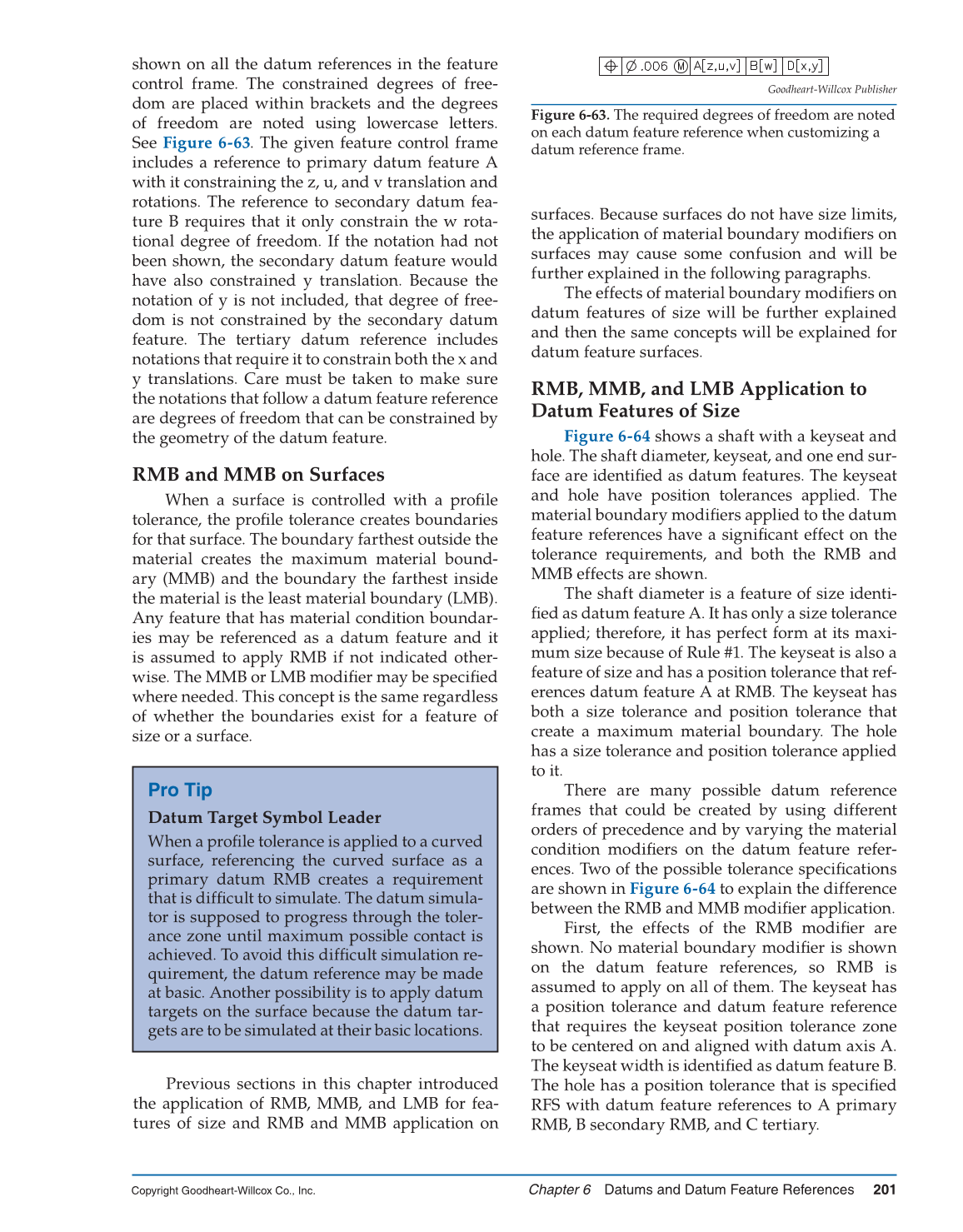Chapter 6 Datums and Datum Feature References 201
Copyright Goodheart-Willcox Co., Inc.
shown on all the datum references in the feature
control frame. The constrained degrees of free-
dom are placed within brackets and the degrees
of freedom are noted using lowercase letters.
See Figure 6-63. The given feature control frame
includes a reference to primary datum feature A
with it constraining the z, u, and v translation and
rotations. The reference to secondary datum fea-
ture B requires that it only constrain the w rota-
tional degree of freedom. If the notation had not
been shown, the secondary datum feature would
have also constrained y translation. Because the
notation of y is not included, that degree of free-
dom is not constrained by the secondary datum
feature. The tertiary datum reference includes
notations that require it to constrain both the x and
y translations. Care must be taken to make sure
the notations that follow a datum feature reference
are degrees of freedom that can be constrained by
the geometry of the datum feature.
RMB and MMB on Surfaces
When a surface is controlled with a profi le
tolerance, the profi le tolerance creates boundaries
for that surface. The boundary farthest outside the
material creates the maximum material bound-
ary (MMB) and the boundary the farthest inside
the material is the least material boundary (LMB).
Any feature that has material condition boundar-
ies may be referenced as a datum feature and it
is assumed to apply RMB if not indicated other-
wise. The MMB or LMB modifi er may be specifi ed
where needed. This concept is the same regardless
of whether the boundaries exist for a feature of
size or a surface.
surfaces. Because surfaces do not have size limits,
the application of material boundary modifi ers on
surfaces may cause some confusion and will be
further explained in the following paragraphs.
The effects of material boundary modifi ers on
datum features of size will be further explained
and then the same concepts will be explained for
datum feature surfaces.
RMB, MMB, and LMB Application to
Datum Features of Size
Figure 6-64 shows a shaft with a keyseat and
hole. The shaft diameter, keyseat, and one end sur-
face are identifi ed as datum features. The keyseat
and hole have position tolerances applied. The
material boundary modifi ers applied to the datum
feature references have a signifi cant effect on the
tolerance requirements, and both the RMB and
MMB effects are shown.
The shaft diameter is a feature of size identi-
fi ed as datum feature A. It has only a size tolerance
applied; therefore, it has perfect form at its maxi-
mum size because of Rule #1. The keyseat is also a
feature of size and has a position tolerance that ref-
erences datum feature A at RMB. The keyseat has
both a size tolerance and position tolerance that
create a maximum material boundary. The hole
has a size tolerance and position tolerance applied
to it.
There are many possible datum reference
frames that could be created by using different
orders of precedence and by varying the material
condition modifi ers on the datum feature refer-
ences. Two of the possible tolerance specifi cations
are shown in
Figure 6-64 to explain the difference
between the RMB and MMB modifi er application.
First, the effects of the RMB modifi er are
shown. No material boundary modifi er is shown
on the datum feature references, so RMB is
assumed to apply on all of them. The keyseat has
a position tolerance and datum feature reference
that requires the keyseat position tolerance zone
to be centered on and aligned with datum axis A.
The keyseat width is identifi ed as datum feature B.
The hole has a position tolerance that is specifi ed
RFS with datum feature references to A primary
RMB, B secondary RMB, and C tertiary.
Goodheart-Willcox Publisher
Figure 6-63. The required degrees of freedom are noted
on each datum feature reference when customizing a
datum reference frame.
Pro Tip
Datum Target Symbol Leader
When a profi le tolerance is applied to a curved
surface, referencing the curved surface as a
primary datum RMB creates a requirement
that is diffi cult to simulate. The datum simula-
tor is supposed to progress through the toler-
ance zone until maximum possible contact is
achieved. To avoid this diffi cult simulation re-
quirement, the datum reference may be made
at basic. Another possibility is to apply datum
targets on the surface because the datum tar-
gets are to be simulated at their basic locations.
Previous sections in this chapter introduced
the application of RMB, MMB, and LMB for fea-
tures of size and RMB and MMB application on
